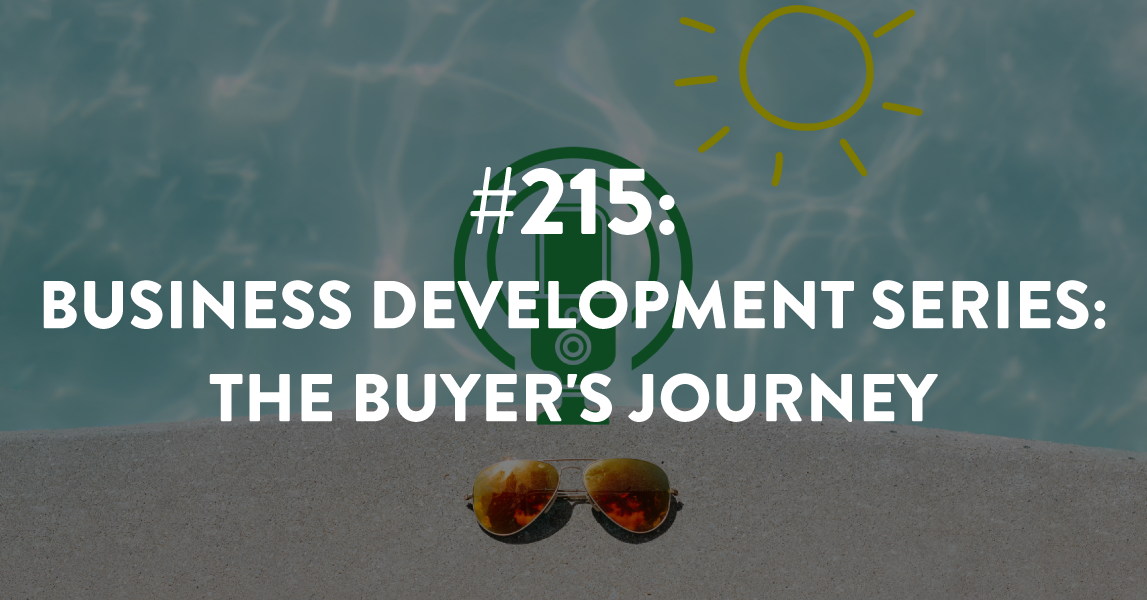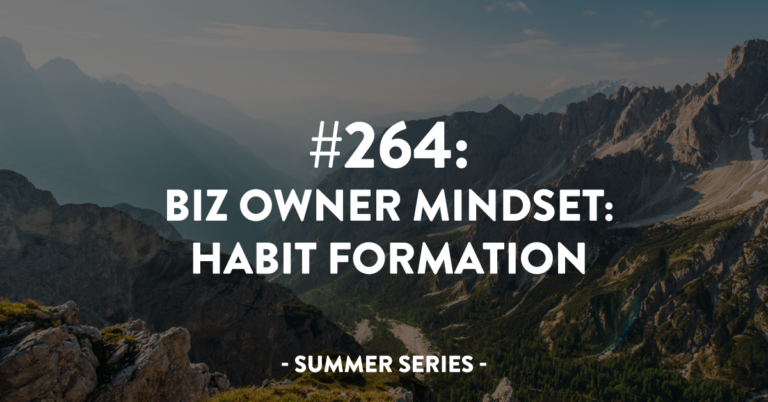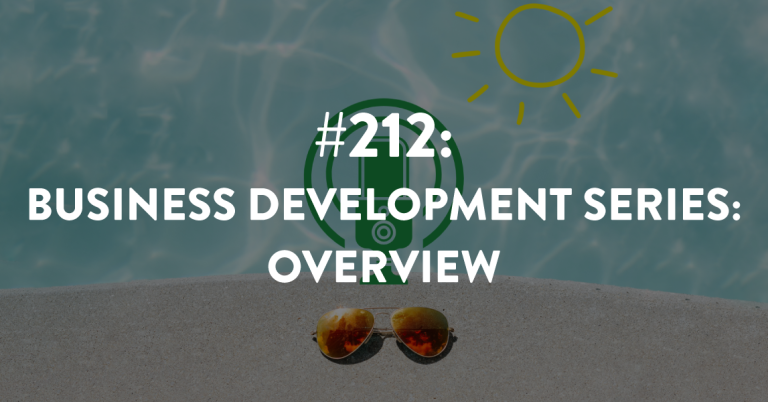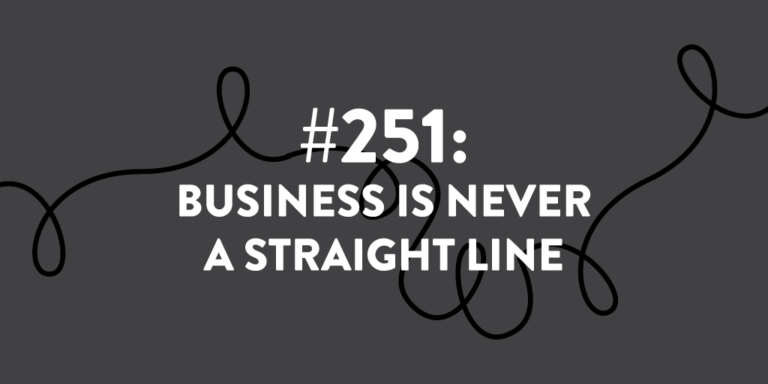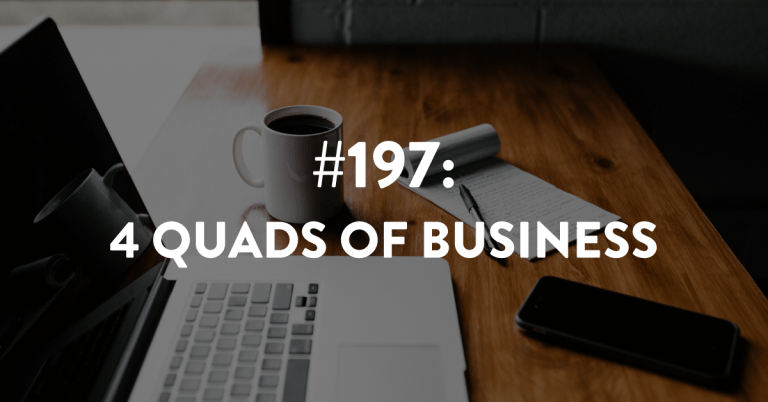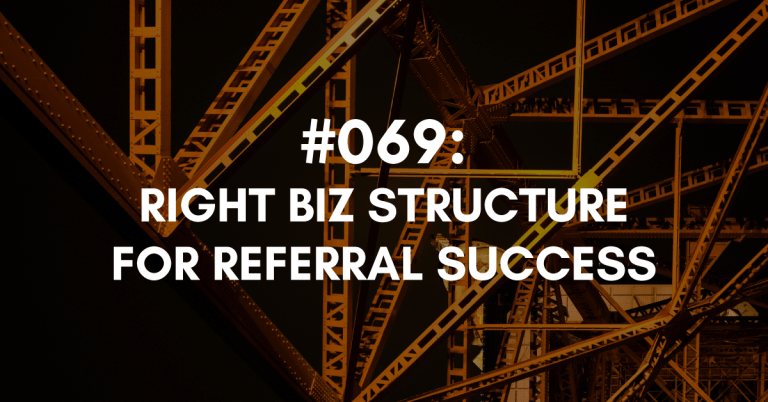Ep #215: Business Development Series: The Buyer’s Journey
Before a prospect decides to buy your product or service, they go on a journey. It’s called the buyer’s journey and while it is their journey, it is absolutely a part of your process.
No matter what industry you’re in or what kind of business you are running, it’s important to have a framework to help you understand who your ideal customers are and how they behave before purchasing. If you examine the choices your buyers make at each stage along the buyer’s journey, then you can identify where your prospects potentially decided not to purchase.
So, in this episode, I will be explaining what exactly the buyer’s journey is, what this will entail and how to make sure you’re making it as easy as possible for your prospects to purchase from you.
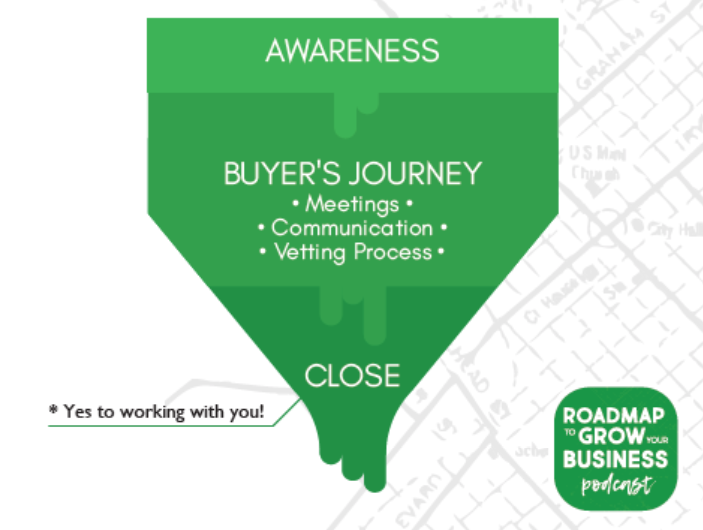
Download the Referred Prospect Meeting Overview PDF Now
Links Mentioned During the Episode:
- How I Stopped Selling and Dramatically Grew My Business Article
- Episode #213: BD Series: Getting Your Message Right
- Episode #214: BD Series: Figuring Out Your Sources
- The Dan Sullivan Question book
Looking for Referral & Client Experience Resources:
Take the Referral Ninja Quiz to test your skills and abilities at generating referrals. (FREE)
Buy my book – Generating Business Referrals Without Asking – and learn how to generate referrals through my 5 steps. (LESS THAN $16)
Consider joining Building a Referable Business™ – a unique way to learn all of my referral strategies and tactics with ongoing weekly access to me to answer your questions and help hold you accountable! Email me for more details.
Coming Up:
Next episode is #216, and we’re going to be talking about closing prospects into clients.
Download The Full Episode Transcript
Read the Transcript Below:
Stacey Brown Randall: Before a prospect gives you a yes or a no, they go on a journey; it’s called the buyer’s journey. And while it’s their journey, it is absolutely a part of your process.
You are not just another hustling salesperson. You are the expert, the
resource, the valuable partner for your clients, and how you grow your
business should reflect how your clients see you.
Welcome to the Roadmap to Grow Your Business podcast. We generate
referrals without asking, build positive client experiences, and help
you take control of your business.
Here’s your charmingly sarcastic host, Stacey Brown Randall.
Stacey Brown Randall: Hey there, and welcome to episode 215 of the Roadmap To Grow Your Business Podcast. I’m your host, Stacey Brown Randall.
So, this episode, as part of our Business Development Summer Series is focused on the buyer’s journey. So, as we are breaking down all the pieces and parts of business development or sales (whatever you want to call it is fine) — but as we are breaking this down step by step, so far, we’ve covered message, and then we’ve covered sources. And sources and today’s topic, buyer’s journey, go hand-in-hand.
So, we’re going to talk about what is the buyer’s journey. We’re going to talk about what’s going on during the buyer’s journey, and the things you need to be aware of. And then of course, I’ll even give you access to a resource that’ll help you with the meeting process, which is one of the pieces within a buyer’s journey when you’re dealing with referred prospects.
So, we’ve got a lot, let’s get to it. I want to make sure we get through all of this so that you understand exactly what the buyer’s journey looks like for you and your business.
Let’s first talk about how the buyer’s journey fits into the sources. Of course, sources, we talked about in our last episode (episode 214), and that was mainly based on when we’re looking at the different sources is where our prospects are coming from.
So, when you’re thinking about where our prospects are coming from, that being their sources, that’s the first kind of overall part within that prospect funnel or pipeline.
So, I’m actually going to put an image of this, I just think it’s really easy for you guys to be able to visualize it. I’m actually going to put an image of the prospect funnel, sometimes called the prospect pipeline. I’m actually going to put an image of that on the show notes page for this episode, staceybrownrandall.com/215, and Stacey has E.
I’m going to put the image of the prospect funnel or pipeline, because I want you to see that there are three parts. There’s the awareness part at the top, then there’s the buyer’s journey, and then there’s the close. And really, think about this as like a funnel that you would pour things into to make liquids go into a smaller opening.
So, think about this as like grab the funnel out of your kitchen cabinet or out of your kitchen drawer. That prospect funnel has three parts; awareness, buyer’s journey, close.
So, where our sources (what we talked about in the last episode) fit into the buyer’s journey is that very first part of our funnel or of our pipeline with prospects, which is the awareness phase. It’s at the top of that funnel is where our sources dump people into our pipeline or our funnel.
So, our sources, maybe you’re getting referrals. That’s some referred prospects being dumped in. Maybe you’re meeting people at networking events, so you have prospects from your networking events being dumped into the top of your funnel.
What’s really funny? You guys can’t visualize this because I know — I’m not going to do a video podcast yet, but I’m actually like pretending I’m pouring something in every time I say this. I talk with my hands so much. I think you guys would laugh at me if you actually watched me visually produce and record one of these episodes, but that’s here nor there.
So, at the top of your prospect funnel or your prospect pipeline is this first part, which is called the awareness part, and it’s where your sources live. And it’s where you can imagine like your sources are dumping people into the awareness phase.
Again, they were referred to you, they’re now being aware of your business. You met them at a networking event. They happened to randomly answer a cold call, which does anyone do that anymore? I know they do, but let’s be honest, it’s super rare.
Maybe that you actually worked with them at an old company, they’re an old colleague. Maybe they came through your contact form on your page because SEO was working. Maybe they clicked on an ad, whether it’s a pay for click ad on Google ads, or maybe it was a Facebook ad.
Whatever source it is, the source is like dumping them into the top of the funnel, which is that very first part, which is the awareness part of your prospect funnel, of your pipeline. So, they’re sitting in there in the awareness phase.
Most of the time, they move past the awareness phase into the second part of the funnel, which is the buyer’s journey. So, that just kind of gives you an idea of how the sources and the buyer’s journey, the awareness phase of where your sources dump into and the buyer’s journey, kind of connect together.
The buyer’s journey, I always like to think about it as like that starting point, is the point at which a prospect becomes a prospect for your business. So, you may meet them at a networking event and in a conversation with you, they may say, “We’ve got to grab coffee because I need to learn more, I think I need to hire you.”
And that’s very quickly, pouring into the awareness phase of that networking event, where they meet you moving right into the buyer’s journey. So, the idea here is, is I want you to kind of first visualize where sources from our last episode connect into the buyer’s journey.
So, that visualization of that image may be super helpful for you guys. If you go to the show notes page for this episode to check it out, because once you understand the awareness is at the top, people dump into the buyer’s journey — at the bottom of the buyer’s journey though, is the third part of this funnel, which is the close.
So, the way I always like to think about this; awareness is where the sources dump people into your funnel. The buyer’s journey is where all the decisions are being made, and the close is the final act where they say, “Yes, I’m going to be a client. No, I’m not or not yet.” So, we’re going to actually talk about the close in next week’s episode. So, right now, we’re staying focused on our buyer’s journey.
So, now, you understand the three parts of that prospect funnel and you understand how sources fit into the buyer’s journey. And you understand that really, the buyer’s journey starts at that point at which the prospect becomes a prospect for your business.
So, let’s dig in a little deeper and talk more about what’s going on during this buyer’s journey. Ultimately, at the end of the day, in the buyer’s journey, your prospect is trying to decide if they should hire you.
Now, here’s the thing to note; while they’re moving through your buyer’s journey, and we’ll talk about probably some of the things, actions or steps that are happening during the buyer’s journey that you’re doing.
But I want you to recognize, in the buyer’s journey, your prospect is trying to decide if they should hire you. Will your solution really be the solution that they are looking for. Will you really be able to solve their problem? Will you really be the person who can get them to whatever promised land it is that they’re ultimately looking for.
But they can also be in a parallel buyer’s journey with one of your competitors. I mean, hopefully not. Hopefully, you met them and they were like, “Oh my gosh, I have to work with you,” but it doesn’t always work that way. Even sometimes when people are referred to you, they may have also been referred to other people.
So, they could also be in a parallel buyer’s journey with a competitor, whether you know it or don’t know it. Just recognize that they could be in a parallel journey. I know for my business specifically, I will talk to people. And a lot of times, not every time — but a lot of times, I will hear them say, “I’ve talked to like five or eight different people about their strategy to help me bring in more clients.”
And they’re trying to sift through in their head, which strategy fits them and feels best for them. I may be the only referral strategy person that they are talking to but that doesn’t mean they’re not also talking to someone who maybe wants to do pay per click ads, or maybe they’re talking to someone who wants to do their social media, or maybe they’re talking to someone that wants to teach them how to sell through webinars or seminars.
There are lots of ways, sources, these are all sources. There are lots of ways to bring clients into your business. And what they’re trying to decide when they’re in your buyer’s journey, whether they’re in a parallel buyer’s journey with a competitor or not, is “Can you solve my problem? Will I make the right decision if I hire you or am I going to waste my time and money?”
That’s the big “if” that’s swirling around in their head. So, everything in your buyer’s journey needs to be about you understanding where they are, what their problems actually are, and what their expectations are as to what it would look like if, and when they were solved.
And making sure A, that you’re a fit for them. And B, how you actually convey that. Now, a lot of this comes back to the messaging, which we learned in our very first episode, which was episode 213, but some of this comes back into messaging.
So, even though I’m taking the parts of our business development strategy or our sales strategy, and I’m breaking them down into individual topics by episode, remember guys, these things all interconnect super important.
So, they’re trying to decide if they should hire you. So, what’s happening while they’re making that decision within the buyer’s journey? Well, ultimately, they could definitely be checking you out online. I mean, you should just assume that that’s happening. They’re doing some kind of Google stalking on some level. They’re definitely checking out your website, I would say at a minimum.
They’re more than likely reviewing your testimonials or online reviews if you have them. That’s getting them a sense of understanding that, oh, they actually can solve people’s problems that have been in the same place as me. Maybe they’re also looking at your social proof. If you have it, where you’ve been published, where you’ve been featured.
They’re probably reviewing any and all material you have. And then of course, there’s probably scheduling and attending meetings with you. It could be a meeting, one meeting, it could be multiple meetings. It kind of depends on how your buyer’s journey works.
And of course, those meetings can be face-to-face or phone call or virtual or … maybe, they’re through webinars. Everyone has that way that they have conversations with prospects before they become a client.
Now, for the people that I work with, for the industries that I work in and the type of business owners that I work with, no one’s doing highly transactional work where they never have a conversation with a prospect before they decide to hire them. You’re not going to hire an attorney or a financial advisor or an interior designer or a real estate agent without having a conversation with them.
That’s who is in my audience. That is more than likely, that’s like you. I mean, I may have not said you’re exact … I mean, maybe you’re an architect or a CPA. I may have not said the exact industry you’re in, but at the end of the day, you’re not Amazon. I’m not going online and deciding, “Yep, I want that book” or “Yes, I want those shoes,” (hello Zappos), and I’m ordering it and I never communicate with you, unless I have a problem.”
So, the way I’m breaking down this whole business development and sales strategy, and in particular, breaking down the buyer’s journey, it’s not the idea that it’s like going to be highly transactional, where I just go to your website, see what I want, you have an e-commerce store and I buy it, and we’re done. Lots of businesses like that. That’s just not who I work with for my referral strategy approach. That’s obviously, not what I attempt to teach.
So, that doesn’t mean based on what you do, like if you sell candles, that process of selling someone will be different if you’re then a financial advisor and you want to have a couple of million of their dollars and AUM (assets under management).
Just processes are going to be different. And I’m going to, of course, stick to the folks that I work with and talk it through from their perspective. But that doesn’t mean you can’t take what’s in this episode and modify it for your own benefit.
So, we know during this buyer’s journey, typically, the buyer’s journey is anchored by a series of meetings or at least, a series of communication that typically involves some type of a meeting. Whether that’s a response over email, or maybe it’s through a webinar, or maybe it is actually a virtual or a face-to-face or phone call type meeting.
But that doesn’t mean, of course, other things aren’t happening. Like they’re checking you out online, they’re reviewing your testimonials, they’re looking at your social proof, and they’re reviewing any of the information that you have. And then of course, they’re reviewing information that you may give them in any of the meetings as well.
So, thinking about all of the things that are happening in the buyer’s journey, I want to really quickly talk about the speed of it and how it ends, and then go back and talk about what you should be doing within your buyer’s journey.
So, remember, whatever they’re deciding to buy from you or however they’re deciding to hire you, and however you guide them through the buyer’s journey — remember, the decision to purchase or the decision to hire is only made when your prospect is emotionally ready to say yes.
Which means your buyer’s journey could be slow or quick, depending on factors like the pain level that your prospect is in, their budget, capacity that they have to get started, and how quickly they move to the trust part of the sales continuum.
And that’s really going to have a lot to do with how fast they trust you, will have a lot to do whether or not you’ve had transferred trust follow them through the journey, which is being referred to you. So, sometimes the buyer’s journey is super short.
Like, hey, you need a new winter coat and you’ve heard amazing things about North Face. So, you stop into one of their stores or you hop on their website and you make a purchase. But other times, the buyer’s journey is much longer.
For example, you’re deciding to change your financial advisor or your CPA, and you’re going to then be taking your time to make the right decision. Of course, the situation we’re in, like I mentioned, like major problem or pain that needed to go away or be solved yesterday, can push us to speed up our decision-making process.
But regardless of the length of the buyer’s journey that our prospect goes through, we all do it. We all go through a buyer’s journey before we purchase anything or hire anyone.
The buyer’s journey is a critical step for buyers as they assess what is offered, consider if it’s going to work for them. And if they trust the person they are hiring to deliver on the promises made.
So, regardless of what your framework of your buyer’s journey ultimately looks like, and we’ll talk about whether you control it or not; you don’t in case you’re wondering, but there are parts to it, you do. So, I’ll come back to that in a minute.
But the thing you need to understand is that this is all in the buyer’s head as they are going through the process of making the right decision, that this is right for them. And there’s a lot of that decision-making process that’s happening in their heads that you’re not a part of because it’s happening in their heads and not necessarily with you.
So, where it ends, of course, or how the buyer’s journey ends, it ends with the decision made by the prospect to hire you, which will happen in that third phase of the pipeline or the funnel called the close phase.
And it’s in the close phase that the buyer or the prospect’s answer is going to be, “Yes, I want to hire you. Nope, I don’t want to hire you or no, not now.” Now, we’ll dig into this close phase in next week’s episode (episode 216).
But I just wanted to kinda give you guys an overview of what you need to be understanding is happening during the buyer’s journey. And the truth is you don’t know if someone has been referred to you and then also, looked you up online and then consume some of your other free content or reviewed every page on your website and shows up for that first meeting, and they’re like, “I’m ready to sign on the dotted line.”
Or someone who’s going to have to really decide if this is the right decision for them, and they could take months and months and months to make that decision. That’s the part of the buyer’s journey that you don’t control. But what you do need to do with the buyer’s journey process is guide it.
So, again, you don’t control it, but you definitely want to guide it to the parts or the pieces of it that you can actually guide. So, understanding what part of the process you guide is typically what information you’re putting out there. And then of course, how you’re handling any meetings that you’re having with your prospect.
So, someone can find me. I’m not even going to use referrals for this example. Let me just use, like someone finds me on LinkedIn, we connect over LinkedIn and they’re starting to check me out. I don’t know that necessarily. Like they could be listening to my podcast episodes, they could be reading my articles on my website. They could buy my book and decide to read it.
So, they found me and they’re consuming my messaging, they’re consuming what I believe and what I teach and they’re consuming my philosophy. But until there’s any kind of outreach where they’re like, “Hey, I’d like to talk to you” or maybe I’ve done the outreach to them and be like, “Hey, how can I help you? Would you like to talk about your referral strategy?” — Until there’s some type of first outreach that they either initiate or I initiate and they say yes to, that’s at the point for me at which my buyer’s journey really begins.
Now, on another side of it, it could also happen when they decide to download some of my content. Because when you download my content, you actually are submitting your name and your email. That’s actually how we deliver the content to you, is a secure link that you can use to download whatever it is, a PDF.
Like last week, we talked about downloading the sales strategy activity PDF. You’re going to give me your name and your email, and put that into my system so that I can then send you the link to where you can download that information. That’s also like you found me and you decided to download something, and then maybe you’re entering the buyer’s journey or maybe not.
So, there’s so many pieces and parts of a buyer’s journey that we don’t control, but there are parts to it that we definitely need to guide. Some of that is in our outreach to ask people where they are in their decision-making process.
Other times, that’s going to happen because your buyer’s journey involves a series of calls or meetings — even mine does. I may not get on the phone call with somebody who’s deciding to join one of my online programs like Growth By Referrals or Referring Machines.
But I may get on the call with somebody who’s deciding to join my group coaching experience, Building a Referrable Business, which is in just an entirely different investment level.
So, you have to figure out what are the things that happen when prospects come to your business through the awareness phase. They’ve been dumped in by a source, what’s the process. And what’s the process really by source.
And it may be like hey, if I meet you at a networking event or you’ve been referred to me, or we catch up for coffee and you decide, hey, maybe you need to hire me, at those points, we’re moving into a meeting-based buyer’s journey.
But if someone’s attending your webinar and you don’t know who they are, or they’re just downloading your free content from your website, your buyer’s journey may start by sending emails. And that may be how the buyer’s journey begins.
So, just thinking through this of how it relates to your business, you could have multiple versions of a buyer’s journey just based on the entry point of where somebody comes to you through a source through that awareness phase.
Most of the people I work with though, you guys have meetings as part of your buyer’s journey, and that’s the best place to guide the buyer’s journey process. You don’t guide if they’re looking at your testimonials or you don’t control if they’re looking at your testimonials.
You don’t control if they’re reviewing your website but you can guide the flow of an actual meeting. So, just keep in mind, it’s not like we’re looking for things we can control, but the things we can guide, we need to guide. And in one of those is the meeting.
If you’re going to have meetings, whether it’s one meeting and they make a decision, or they have seven meetings before they make a decision, depending on what it is that you do; and whether they’re paying for that meeting because let’s say you’re an interior designer and they want to talk to you about working together, and they want to design consultation and maybe you charge for that because you’re actually going to produce something for them. And then they still, at that point, may say yes or no to moving forward with that design.
This whole idea from this perspective is if there’s meetings involved in your buyer’s journey, that is a piece where you should definitely be guiding the flow or the process of those meetings.
Now, I teach a specific process with a couple of critical questions as one of my referral strategies. It’s called the First Meeting Script. And I do teach a very specific process with these critical questions for referred prospects.
Now, this referral strategy, it’s called the First Meeting Script. It’s available for my BRB (Building a Referral Business) members. But ultimately, it has this specific process that it has, is a seven-part.
So, I have pulled out an overview for you where you can have access to this overview of how a meeting would go with somebody who is going through your buyer’s journey.
Now, it is written specific for referred prospects. But of course, if you just eliminate step two, you can modify it for any type of prospect that you’re working with.
So, let me just say that again; you can download this one-page PDF that’s going to give you this seven parts of an overview of how a first meeting could go with a prospect. Remove step two if they’re not a referred prospect.
This is not in detail the referral strategy that I teach for my BRB members. But I do think for the purpose of this episode and you guys being like, “Let me get something on paper or let me understand what a process would look like,” having a flow to your meetings, which is the number one thing that you have the best chance at controlling during your buyer’s journey, is really important.
Because at the end of a meeting, you’re also going to establish next steps, which continues to allow you to guide that buyer’s journey. Now, I’m not getting into the extreme in the weeds tactical things that you do within a buyer’s journey because they all look different for every single business.
The buyer’s journey for an interior designer is just going to look different for a financial advisor. The same way the buyer’s journey for an attorney is probably going to look a little bit different than a real estate agent.
So, I just want you to think through understanding like what is the buyer’s journey, what’s going on in the mind of our prospect when they’re in the buyer’s journey? What’s probably happening that you’re guiding or not guiding, understanding when it starts and when it stops. And then the part of it that you can guide, you need to have a process for.
And the biggest part of your buyer’s journey that you can guide is what’s happening in the meetings that you have with your prospects. And so, of course, in those meetings, it also leads to next steps and follow up, all of which you can guide and, in some ways, own that process of what you’re going to send and what you’re going to provide.
So, again, you can access what I did is I pulled together for you a meeting overview. It is specific for referred prospects, but you would just remove step two and then you can modify it for any type of prospect as well if you’re having meetings as part of your buyer’s journey.
Another resource that may be helpful for you if you want to check this out is a book called The Dan Sullivan Question. It is literally the tiniest book, I think, on the planet. And it is a super — okay, it’s not the tiniest book on the planet, but it’s really small. And it is a super-fast read and it is extremely repetitive, but it is powerful.
And I have used The Dan Sullivan Question. It’s literally, he’s teaching you one question. If you don’t want to read the book, you can Google The Dan Sullivan Question and then literally, Google results will tell you what the question is.
But as an author, I believe that you should go and buy the book to really understand the thought process behind the one question that you could just Google. I think it’d be great if you read the book.
But that can actually give you some additional resources of like what to say or ask, because he teaches this one specific question that you can use within a meeting that you’re having within any of your prospects.
I usually use that question — sometimes I use it almost all the time when I’m talking to somebody who’s not referred to me, but of course, I even use it when I’m talking to folks that are referred to me as well.
So, you can download the seven-part framework, one page PDF from the website and that’s on the show notes page for this episode, which is staceybrownrandall.com/215 for episode 215, and Stacey has an E.
And then I’ll also give The Dan Sullivan Question, that book, I’ll put that link in the show notes page as well. And there’s actually another article that I have on my website called How I Stopped Selling and Dramatically Grew My Business. I’m also going to link to that article, which goes into using this meeting overview in more detail as well.
But here’s what I want you to know, here’s what I want you to understand; your clients come to you as prospects through a source. That source is what brings them into your awareness phase. Then they move from the awareness phase into the buyer’s journey where decisions are being made. Most of them almost always made emotionally when they make the decision to say yes or no.
And then they move into the final step. The third part of the prospect funnel known as the close, where they’re actually making their decision. I call that the final act. They’re not always because it could be not yet is their answer, which means you’re now doing follow up.
We’ll dive into that in next episode. But just understanding what the buyer’s journey looks like for your business, what are the sources that brings people into the buyer’s journey, and then what’s happening while they’re in that buyer’s journey.
And then making sure the part of the process that you are part of, the guide that you’re actually guiding that process, like meetings, follow-up, communication, things like that, have a process to it.
And then of course, download our meeting overview and look up the resources that I’ve mentioned in this episode as well.
So, this is the buyer’s journey. Next, we got to talk about closing those folks, those prospects into clients. And so, we will do that next week in episode 216, we talk about the close.
So, until then, my friend, take control and grow your business. Bye for now.
Thanks for listening to the Roadmap to Grow Your Business podcast. To
access all resources and links mentioned in today’s show, and to
connect with Stacey, head over to www.staceybrownrandall.com.

